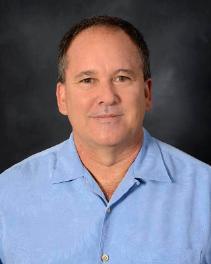
Dr. Wade Jeffrey
- Director of CEDB, Distinguished University Professor of Biology, Director of Reubin O'D. Askew Institute of Multidisciplinary Studies
Biography
Dr. Wade Jeffrey is a Distinguished University Professor, Director of the Center for Environmental Diagnostics and Bioremediation and Director of the Reubin O'D. Askew Institute of Multidisciplinary Studies. Jeffrey is an oceanographer focusing on bacterial function and diversity in the ocean. He studies the effects of ultraviolet radiation on marine microbes and has worked around the globe. He has also been involved with projects examining the effects of oil on microbial communities in the Gulf of Mexico, spawned by the 2010 BP oil spill.
A UWF faculty member since 1991, he has taught many courses, including Biological Oceanography, Climate Change Biology and Professional Development in Biology. Jeffrey has raised more than $6.5 million in outside funding for research projects that involved him, other faculty members and students. Jeffrey earned a Ph.D. and an M.S. in Marine Science from the University of South Florida and a B.S. in Biology from Virginia Polytechnic Institute and State University. He also was a Postdoctoral Fellow at the EPA Research Laboratory on Pensacola Beach.
Numerous publications have carried his findings in leading journals including Nature, Nature Microbiology, Limnology and Oceanography, and Biogeosciences. He has represented UWF on the Florida Institute of Oceanography’s advisory committee for over 15 years. In addition he has been Associate Editor since 2004 of Limnology and Oceanography, which publishes original research articles, reviews, and comments about all aspects of limnology (the study of inland waters) and oceanography.
Education
Postdoctoral Fellow, EPA Research Laboratory
Ph.D. Marine Science, , University of South Florida
M.S. Marine Science, University of South Florida
B.S. Biology Virginia Polytechnic Institute and State University
Research
I am trained as an oceanographer with a specialization in marine microbial ecology. For most of my career I have focused on how ultraviolet radiation (UV) affects marine microbes. Since UV is almost everywhere, my lab has worked from the Arctic to Antarctic oceans, coral reefs, mountain lakes, the Mediterranean Sea, and our backyard in the Gulf of Mexico. Most recently I have begun to investigate the extreme environments found in the Atacama Desert in Chile. My approach combines aspects of microbiology, oceanography, molecular biology, and photobiology. Since 2010 I have also been heavily involved with research associated with the Deepwater Horizon oil spill. We have done extensive work on the microbial diversity of the northeast Gulf of Mexico and how it is affected by oil. My current work focuses on how environmental parameters (for example sunlight, temperature, salinity) interacts with oil to change its toxicity to marine microbes.
Publications
Horak, R.E.A., W. Qin, A. Bertagnolli, A. Nelson, K. Heal, H. Han, M. Heller, A. Schauer, W.H. Jeffrey, E.V. Armbrust, J.W. Moffett, A.E. Ingalls, D.A. Stahl, and A.H. Devol. 2017. Influence of light and temperature upon ammonia oxidation activity in marine Thaumarchaeota in the North Pacific Ocean. Limnology and Oceanography doi:10.1002/lno.10665
Pérez, V., M. Hengst, L. Kurte, C. Dorador, W.H. Jeffrey, R. Wattiez, S. Matallana-Surget. 2017. Adaptation to Extreme UV Radiation: A comparative proteomics study ofRhodobactersp, isolated from high altitude wetlands in Chile.Frontiers in Microbiology. 8:1173 doi: 10.3389/fmicb.2017.01173.
Nienow, J.A., R.A. Snyder, W.H. Jeffrey, and S. Wise, Jr. 2016. Fine Structure and ecology of Nanoneis longta in the northeastern Gulf of Mexico with a revised definition of the species. Diatom Research32:43-58. doi.org/10.1080/0269249X.2016.1268978.
Hernandez, K., B. Yannicelli, L.M. Olsen, C. Dorador, R. Menschel, V. Molina, F. Remonsellez, andW.H. Jeffrey.2016. Microbial Activity Response to Solar Radiation across Contrasting Environmental Conditions in Salar de Huasco, Northern Chilean Altiplano.Frontiers in Microbiology. doi: 10.3389/fmicb.2016.01857
Moss, J.A., C. McCurry, P. Schwing, andW.H. Jeffrey, I.C. Romero, D.J. Hollander, and R.A. Snyder. 2016. Molecular characterization of benthic foraminifera communities from the Northeastern Gulf of Mexico shelf and slope following the Deepwater Horizon Event. Deep Sea Research I115: 1-9.
Vaughan, P.A., T. Wilson, R. Kamerman, M. Ederington-Hagy, A. McKenna, H. Chen, andW.H. Jeffrey. 2016. Photochemical Changes in Water Accommodated Fractions of MC252 and Surrogate Oil Created during Solar Exposure as determined by FT-ICRMS. Marine Pollution Bulletin104: 262-268. DOI:10.1016/j.marpolbul.2016.01.012
Billerbeck, S., B. Wemheuer, S. Voget, A. Poehlein, H-A. Giebel, T. Brinkhoff, L. Gram, W.H. Jeffrey, R. Daniel, and M. Simon. 2016. CHAB-I-5: Biogeography and environmental genomics of the pelagic Roseobacter lineage CHAB-I-5. Nature Microbiology. doi:10.1038/nmicrobiol.2016.63.
Moss, J.A., C. McCurry, S. Tominack, I.C. Romero, D. Hollander, W.H. Jeffrey, and R.A. Snyder. 2015. Ciliate protists from the sediment-water interface in the Northeastern Gulf of Mexico. Deep Sea Research I 106: 85-96.
Sanders,, R.W., S.L. Cooke, J.M. Fischer, S.B. Fey, A.W. Heinze, W.H. Jeffrey, A.L. Macaluso, R.E. Moeller, D.P. Morris, P.J. Neale, M. Olson, J.D. Pakulski, J.A. Porter, D.M. Schoener, and C.E. Williamson. Shifts in microbial food web structure and productivity after additions of naturally occurring dissolved organic matter: results from large-scale lacustrine mesocosms. Limnology and Oceanography 60: 2130-2144.
Cooke, S.L., J.M. Fisher, K. Kessler, C.E. Williamson, R.W. Sanders, D.P. Morris, J.A. Porter, andW.H. Jeffrey, S.B. DeVaul, and J.D. Pakulski. 2015. Direct and indirect effects of chromophoric dissolved organic matter additions on zooplankton in an oligotrophic lake. Freshwater Biology 60: 2362-2378


